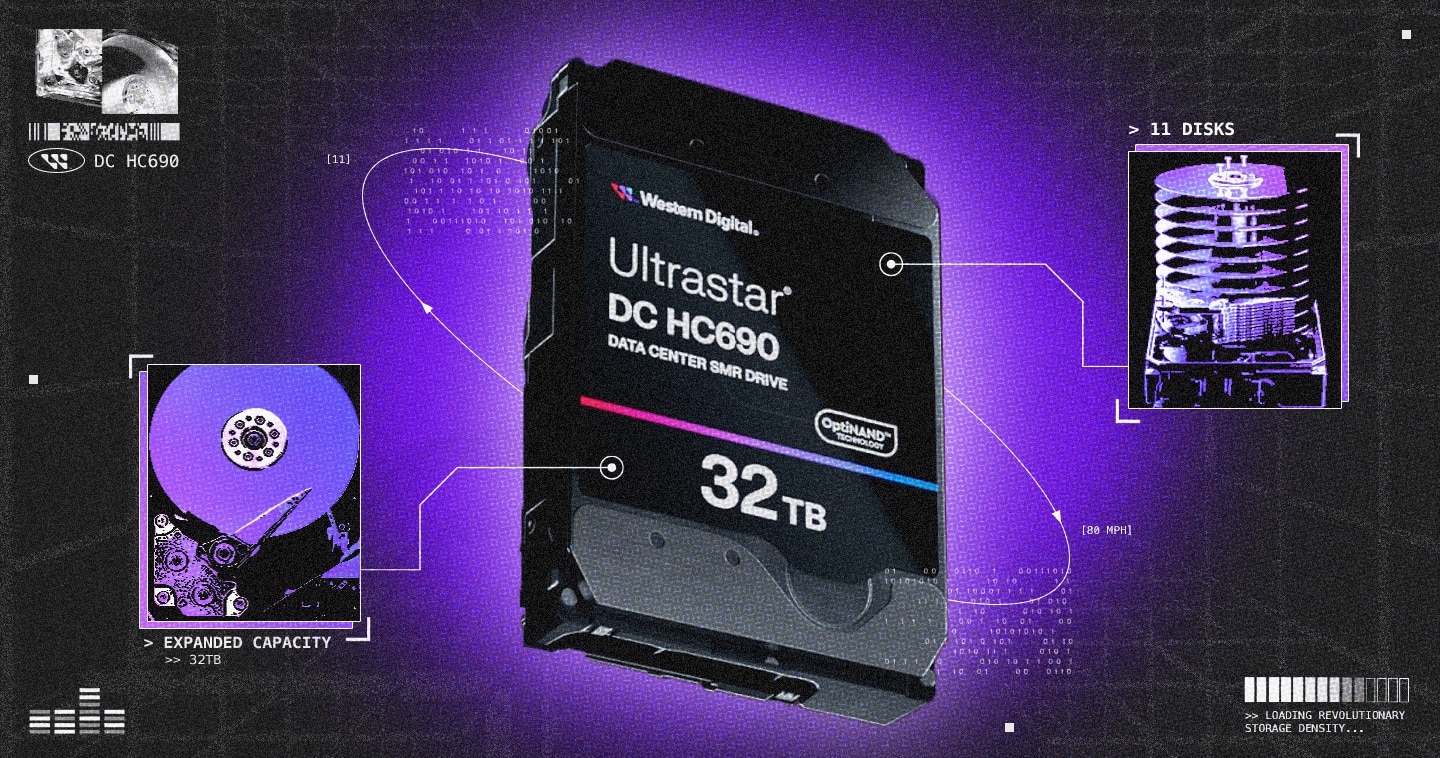NVMe-oF Full Speed Ahead
As users expect fast response times from increasingly massive amounts of data, data center architects at cloud service providers and OEMs are furthering their investment in NVMe™ and NVMe-oF™ into their IT infrastructures.
Western Digital launched its next step in NVMe and NVMe-oF with enhanced versions of its OpenFlex™ Data24 NVMe-oF storage platform, next-generation RapidFlex A2000 and C2000 NVMe-oF fabric bridge devices (FBDs), and the new Ultrastar® DC SN655 PCIe® Gen 4.0 dual-port NVMe SSDs.
“The NVMe-oF protocol accelerates the adoption of next-generation storage architectures, such as disaggregated storage-compute to scale capacity and compute independently, use of software-defined storage and hyperconverged and composable infrastructures,” according to Gartner® in a June 2023 report titled Block Storage Trends: NVMe Over Fabric.
“We’re seeing increased adoption and movement in NVMe-oF among our customers, initially with the cloud titans’ proprietary architectures,” said Scott Hamilton, senior director of product management at Western Digital. “Today we’re bringing our proven, vertically integrated solutions to CSPs and XSPs so they can gain the efficiency of optimizing utilization without sacrificing performance.”
Additionally, Hamilton believes Ethernet will be the fabric of choice for storage in the future.
“CSPs and XSPs are moving away from SAS and moving toward Ethernet, starting with flash,” said Hamilton. “When we first developed our disaggregated architecture, we chose Ethernet because it’s the most ubiquitous fabric on the planet. It’s also going to be the most cost-effective.”
Why NVMe/NVMe-oF?
Legacy protocols such as SAS were not designed for high-speed storage media. PCI Express (PCIe), on which NVMe is based, emerged as the next logical storage interface because of its speed and proximity to the CPU. NVMe-oF takes the performance benefits of NVMe one step further by sharing flash resources among servers for improved performance, availability, and flexibility.
Pure-play cloud storage provider Wasabi is among the companies turning to NVMe and NVMe-oF for its speed. Wasabi’s Hot Cloud Storage gives customers fast access to their data.
“NVMe offers a standardized protocol for accessing storage and provides a reliable, high-performance transport,” said Pramod Kalyanasundaram, SVP, engineering and operations at Wasabi. “NVMe and NVMe-oF fit into our infrastructure at the storage layer in environments that demand higher throughputs and IOPs and are an integral part of our service delivery.”
Object storage vendor Cloudian is moving toward disaggregation for its cloud-native solutions.
“As our customers’ workloads become more performance-intensive, they require increasingly faster media to support them,” said Glenn Haley, senior director of product management at Cloudian. “Workloads including AI, data lakes, and data warehouses are driving a shift in object storage from backup and recovery to primary storage. NVMe and NVMe-oF enable this transition to support mainstream workloads requiring analytics.”
Resources on demand
In a traditional SAS-based hyper converged infrastructure (HCI) storage and compute both reside in the same server, regardless of how much of each is required. As a result, storage can be trapped in that server. NVMe-oF disaggregates resources so they can be pooled together and used as needed, then released for another workload to use.
The ICM Brain and Spine Institute relies on Western Digital’s OpenFlex platform to resize and reallocate storage volumes on demand, assisting the institute’s fight against neurological disorders.
ICM’s IT team has the flexibility to quickly and easily allocate storage to meet any researcher’s need and resize and reallocate storage volumes on demand. This ability to seamlessly add more resources as technology advances allows ICM to future-proof its IT model and investment.
Avoids over-provisioning
Another benefit of shared storage is to avoid overprovisioning resources. In a hyperconverged infrastructure, if more capacity is needed, storage and compute are added in equal increments, whether or not more of both are required. Organizations often overprovision because they don’t want to run out of capacity when they need it.
Telefónica, serving more than 345 million customers in Europe and Latin America, moved to a disaggregated infrastructure for their content delivery network. Livestreaming and video-on-demand (VOD) have different storage requirements, based on whether many subscribers are accessing the same event simultaneously or if subscribers are choosing from a large catalog of diverse content. Deploying both storage and compute in the same server decreases efficiency and increases costs. Using NVMe-oF enables Telefónica’s servers to share a common pool of storage capacity shared across multiple servers, thereby lowering costs while maintaining high performance.
Optimizing utilization
Keeping storage independent from servers also avoids underutilizing resources because the cadence of storage and servers doesn’t necessarily coincide. By decoupling the SSD refresh from the server refresh and sharing externally via Ethernet, customers can use flash on demand as opposed to populating the server with five to seven years of flash at initial deployment and hoping the flash will be consumed over the lifetime of a server.
“If you’re not adequately utilizing resources or when a server needs to be retired (and both storage and compute are trapped in that server) you end up with wasted resources,” said Hamilton. “TCO adds up when maximizing usage with a shared pool of resources on demand.”
Data recovery
According to Western Digital Platforms CTO Barrett Edwards, in addition to its flexibility, disaggregation also enables faster recovery time objectives (RTO) because data is not stored in servers but on shared drives.
“With a disaggregated infrastructure, you take the drives out of those servers and put them in a remote storage enclosure or a shared storage enclosure,” said Edwards. “The servers are stateless. If a server goes down nothing is lost because data does not reside on that server.”
A leading data protection company provides backup, recovery, and archiving both in the cloud and on-premises. They’re adopting flash-based NVMe-oF using Western Digital’s OpenFlex Data24 NVMe-oF storage platform for quick data recovery.
Enabling an ecosystem
Data centers are incorporating flash and NVMe for workloads requiring higher performance and lower latency. NVMe-oF delivers TCO by optimizing resources and utilization.
Western Digital is a trusted partner for organizations deploying NVMe-oF and makes it easy to share flash storage among workloads. The company’s enhanced solutions further the NVMe and NVMe-oF ecosystem, providing more flexibility and choice as CSPs and OEMs turn to these faster protocols for their modern infrastructures.
The company will be showcasing the enhanced products at Flash Memory Summit August 8-10, 2023. Western Digital Platforms CTO Barrett Edwards will deliver a keynote address on “Advancing Composable Infrastructure with NVMe over Fabric”.
GARTNER is a registered trademark and service mark of Gartner, Inc. and/or its affiliates in the U.S. and internationally and is used herein with permission. All rights reserved.
Artwork by Cat Tervo




